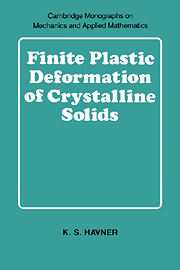Book contents
- Frontmatter
- Contents
- Preface
- 1 An Historical Introduction
- 2 The Kinematics of Double Slip
- 3 A General Theory of Elastoplastic Crystals
- 4 Axial-Load Experiments and Latent Hardening in Single Crystals
- 5 Analysis of Crystals in Channel Die Compression
- 6 Theoretical Connections between Crystal and Aggregate Behavior
- 7 Approximate Polycrystal Models
- Appendix: The General Theory of Work-Conjugate Stress and Strain
- References
- Index
3 - A General Theory of Elastoplastic Crystals
Published online by Cambridge University Press: 11 September 2009
- Frontmatter
- Contents
- Preface
- 1 An Historical Introduction
- 2 The Kinematics of Double Slip
- 3 A General Theory of Elastoplastic Crystals
- 4 Axial-Load Experiments and Latent Hardening in Single Crystals
- 5 Analysis of Crystals in Channel Die Compression
- 6 Theoretical Connections between Crystal and Aggregate Behavior
- 7 Approximate Polycrystal Models
- Appendix: The General Theory of Work-Conjugate Stress and Strain
- References
- Index
Summary
In setting down a general continuum mechanics description of finite deformation processes in metal crystals that takes into account both lattice straining and gross crystallographic slip, it is useful to begin with an assessment of the minimum physical scale at which such a description has meaning. The following discussion, based upon similar discussions in Havner (1973a,b; 1982a), is pertinent to the determination of that minimum scale.
As seen by an observer resolving distances to 10−3 mm, the deformation of a crystal grain (of typical dimensions 10−3−10−2 cm within a finitely strained polycrystalline metal) may be considered relatively smooth. At this level of observation, which for convenience we shall call microscopic, one can just distinguish between slip lines on crystal faces after extensive distortion of a specimen. In contrast, a submicroscopic observer resolving distances to 10−5 mm (the order of 100 atomic spacings) is aware of highly discontinuous displacements within crystals. The microscopic observer's slip lines appear to the submicroscopic observer as slip bands of order 10−4 mm thickness, containing numerous glide lamellae between which amounts of slip as great as 103 lattice spacings have occurred, as first reported by Heidenreich (1949); hence a continuum perspective at this second level would seem untenable. Accordingly, we adopt a continuum model in which a material “point” has physical dimensions of order 10−3 mm. This is greater than 103 lattice spacings yet at least an order of magnitude smaller than typical grain sizes in polycrystalline metals.
- Type
- Chapter
- Information
- Finite Plastic Deformation of Crystalline Solids , pp. 34 - 66Publisher: Cambridge University PressPrint publication year: 1992
- 1
- Cited by



